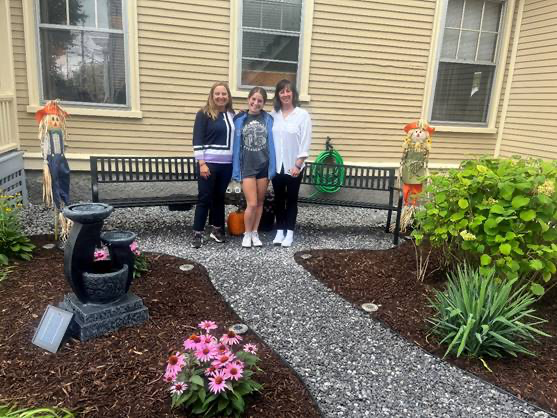Bedford Historical Society converting former schoolhouse to community center
The Stevens-Buswell School is cold and empty right now, but if Joan Shaw Reeves, Susan Tufts-Moore and the rest of the Stevens-Buswell Community Center Committee have their way, the building will become a warm, cozy place for Bedford residents to gather and local organizations to meet.
It won’t be the first time the Stevens-Buswell School (soon to be the Stevens-Buswell Community Center) has been adapted to suit the town’s changing needs. First erected in 1921, the structure started out as a two-room schoolhouse, expanding to a four-room schoolhouse in 1938.
The building ceased to be a school in the late 1960s and then served various purposes for the town. It last was used to house the U.S. Marconi Museum and sat vacant and unmaintained from the museum’s closure in 2007 until October 2010, when the Bedford Historical Society began restoration work after a period of consulting with the Town Council and other planning.
For Shaw Reeves and Tufts-Moore, who were co-presidents of the Bedford Historical Society when this project was undertaken, bringing the Stevens-Buswell School back to its former glory is a labor of love.
Shaw Reeves attended first through eighth grade there when it was a four-room schoolhouse. “This place has a lot of memories for me,” she said.
These memories, apparently, are still as clear as a bell. “First and second grade were over here,” she said during a tour, indicating the rooms to the left of the entryway. These rooms ultimately will house space for the Bedford Historical Society and a library dedicated to local history and genealogy.
Like Shaw Reeves, Tufts-Moore, who began first grade at the Stevens-Buswell School, has no difficulty visualizing the past and the future in the same place.
The room to the right of the entryway, which, Tufts-Moore explained, was one of the building’s two original classrooms, will be redesigned as a meeting space complete with comfortable couches and a coffee area.
The long room at the back of the first floor, added in 1938, is being reimagined as a performance space. There was originally a stage at one end of the room as well as a folding partition that allowed the room to be divided into two separate spaces, both features that the women intend to bring back.
The room’s blackboard and original light fixtures were saved during the renovation process, Tufts-Moore noted, and will be reinstalled once the building is complete.
The basement will include storage space, a kitchen and additional restrooms, and the building also will feature an elevator.
Although there is a need to bring everything up to code, “we’re trying to give it the feel of the old building,” Shaw Reeves said.
At present, the building’s interior is merely a skeleton, with partitions and electrical wiring indicating the hoped-for future uses of the space. The partitions were paid for through a New Hampshire Conservation License Plate Grant, and the electrical work was paid for by a grant from the Lowe’s Charitable and Educational Foundation through a fund administered by the National Trust for Historic Preservation.
Ultimately, that’s what the success of the community center depends on: funding. No taxpayer money is being spent on this undertaking, which is being funded solely by donations from businesses and residents, the fundraising efforts of the Stevens-Buswell Community Center Committee, and grants obtained by Shaw Reeves and Tufts-Moore. And there’s still a long way to go.
According to Tufts-Moore, even though the building is ultimately for the community, the community’s awareness of this endeavor is relatively low. “People we’ve talked to about our project are very enthusiastic,” she said, “but we realize there are many, many people in town who don’t realize we’re working on this project.
“As a result, we haven’t seen the financial support we were hoping for by now from the townspeople.”
Rather than restoring it solely as a historical structure, Shaw Reeves, Tufts-Moore and their committee envisioned the Stevens-Buswell School as filling a crucial need for community space in Bedford.
The Bedford Public Library has only two rooms for meetings, Tufts-Moore noted, and the town has many clubs and organizations.
In addition to being available for scheduled meetings, classes and concerts, the community center will be “a gathering place for seniors and veterans and teenagers after school,” she said.
The door to the Stevens-Buswell School sticks a little bit right now, but with the support of the community, it will eventually be swinging open and shut on a regular basis.
“We hope to have it open every day,” Shaw Reeves said of the community center.
Teresa Santoski can be reached at 594-6466 or tsantoski@nashuatelegraph.com.






